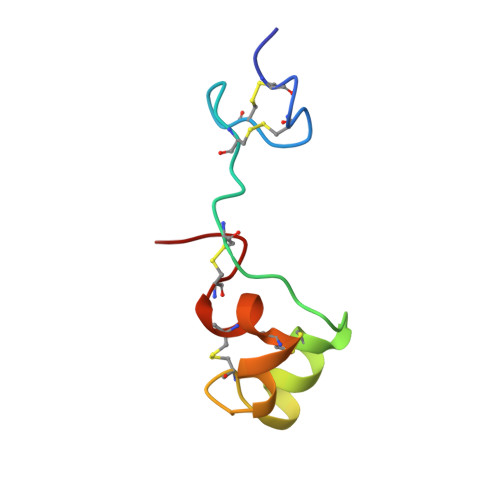The cysteine-rich secretory protein domain of Tpx-1 is related to ion channel toxins and regulates ryanodine receptor Ca2+ signaling.
Gibbs, G.M., Scanlon, M.J., Swarbrick, J., Curtis, S., Gallant, E., Dulhunty, A.F., O'Bryan, M.K.(2006) J Biological Chem 281: 4156-4163
- PubMed: 16339766
- DOI: https://doi.org/10.1074/jbc.M506849200
- Primary Citation of Related Structures:
2A05 - PubMed Abstract:
The cysteine-rich secretory proteins (Crisp) are predominantly found in the mammalian male reproductive tract as well as in the venom of reptiles. Crisps are two domain proteins with a structurally similar yet evolutionary diverse N-terminal domain and a characteristic cysteine-rich C-terminal domain, which we refer to as the Crisp domain. We presented the NMR solution structure of the Crisp domain of mouse Tpx-1, and we showed that it contains two subdomains, one of which has a similar fold to the ion channel regulators BgK and ShK. Furthermore, we have demonstrated for the first time that the ion channel regulatory activity of Crisp proteins is attributed to the Crisp domain. Specifically, the Tpx-1 Crisp domain inhibited cardiac ryanodine receptor (RyR) 2 with an IC(50) between 0.5 and 1.0 microM and activated the skeletal RyR1 with an AC(50) between 1 and 10 microM when added to the cytoplasmic domain of the receptor. This activity was nonvoltage-dependent and weakly voltage-dependent, respectively. Furthermore, the Tpx-1 Crisp domain activated both RyR forms at negative bilayer potentials and showed no effect at positive bilayer potentials when added to the luminal domain of the receptor. These data show that the Tpx-1 Crisp domain on its own can regulate ion channel activity and provide compelling evidence for a role for Tpx-1 in the regulation of Ca(2+) fluxes observed during sperm capacitation.
- Monash Institute of Medical Research, Monash University, Clayton, Melbourne, Victoria, Australia.
Organizational Affiliation:
















